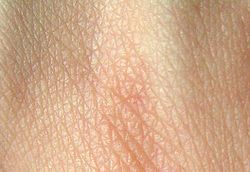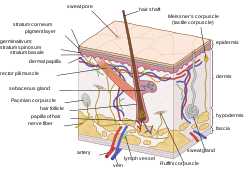
Back جلد الإنسان Arabic Kublit nin tawo BCL ত্বক Bengali/Bangla Pell humana Catalan Lidská kůže Czech Piel humana Spanish Giza azal Basque پوست انسان Persian Peau humaine French עור האדם HE
| Human skin | |
|---|---|
 Skin of a human hand | |
 | |
| Details | |
| System | Integumentary system |
| Identifiers | |
| Latin | cutis |
| TA98 | A16.0.00.002 |
| TA2 | 7041 |
| TH | H3.12.00.1.00001 |
| FMA | 7163 |
| Anatomical terminology | |
The human skin is the outer covering of the body and is the largest organ of the integumentary system. The skin has up to seven layers of ectodermal tissue guarding muscles, bones, ligaments and internal organs. Human skin is similar to most of the other mammals' skin, and it is very similar to pig skin. Though nearly all human skin is covered with hair follicles, it can appear hairless. There are two general types of skin: hairy and glabrous skin (hairless). The adjective cutaneous literally means "of the skin" (from Latin cutis, skin).
Skin plays an important immunity role in protecting the body against pathogens and excessive water loss. Its other functions are insulation, temperature regulation, sensation, synthesis of vitamin D, and the protection of vitamin B folates. Severely damaged skin will try to heal by forming scar tissue. This is often discoloured and depigmented.
In humans, skin pigmentation (affected by melanin) varies among populations, and skin type can range from dry to non-dry and from oily to non-oily. Such skin variety provides a rich and diverse habitat for the approximately one thousand species of bacteria from nineteen phyla which have been found on human skin.